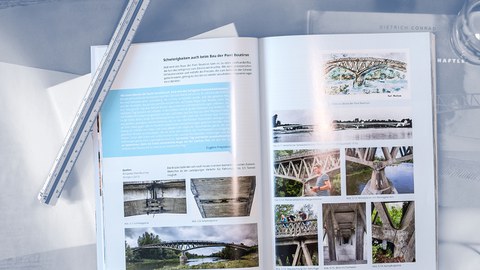Bridge Building Excursion 2022 – France
On the trail of the ancient Romans to current world records - bridge building excursion of the Institute of Concrete Structures through France
In summer 2022, the annual bridge construction excursion of the Institute of Concrete Structures of Technische Universität Dresden took place. Together with Prof. Steffen Marx and 3 research assistants, 22 civil engineering students took part in the 11-day excursion across France. The almost 3500 km long route took us from Dresden via Paris to the Mediterranean Sea and back via the French Alps to Germany. During the eleven-day excursion, we visited numerous bridges, both existing and under construction. Modern and historical masterpieces of civil engineering were on our route, such as the Viaduc de Millau or the 2000-year-old Pont du Gard. The excursion started in August during the semester break.
The excursion was preceded by a planning phase lasting about six months, during which the students had to organise themselves into individual working groups. There were individual "task groups" for route planning, accommodation, mobility and sponsoring. By planning independently, the students had the opportunity to deal intensively with the excursion and the buildings to be visited in advance. We have the task group "Sponsoring" to thank for the fact that once again last year many companies and even private individuals agreed to financially support our excursion. Such an undertaking would otherwise not be feasible.
With the end of the exam period in August, we were able to start our excursion together early in the morning. The first stop was the construction site on the BAB 49 motorway in Schwalmstadt. A bridge was being built there in the first construction phase using the semi-integral construction method. After an informative guided tour by the responsible construction manager, we reached the first stage destination in Düsseldorf in the evening. We spent the first evening at the foot of the Rheinkniebrücke.
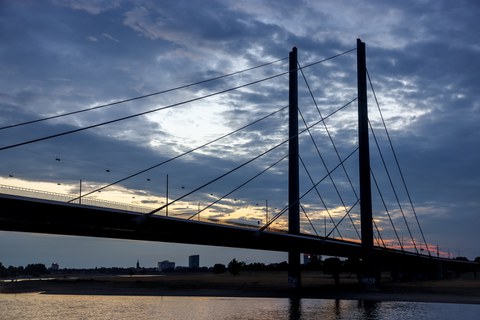
Rheinkniebrücke
At the beginning of the second day, we had the opportunity to visit the construction site of the U81 (Nordstern) light rail line in Düsseldorf. Particularly impressive was the steel truss bridge with an overhead central girder, which is being constructed using the incremental launching method over the A44 motorway.
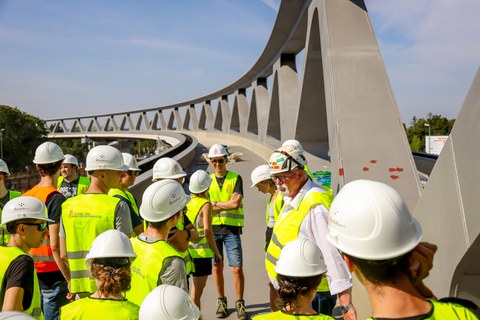
Visit to the U81 light rail line in Düsseldorf
The destination of the second day was Paris. The itinerary therefore led via Belgium to France. The first stop in "La République française" was the Pont de Luzancy. With its 55 m span as a two-hinged frame bridge, this bridge is one of the first prefabricated prestressed concrete bridges ever designed by Eugène Freyssinet. The superstructure of the bridge, which was begun in 1941 and completed in 1946, consists of three box girders 1.7 m wide. The individual box girders were assembled from 2.4 m long prefabricated elements that were prestressed in all directions and connected with prestressing strands. The web thicknesses are very low with a height of 10 cm. The individual girder height is 1.75 m at the abutments and 1.22 m at the apex. This results in a slenderness of 1:45. This low slenderness or this construction method was pioneering at the time of construction and still is today.
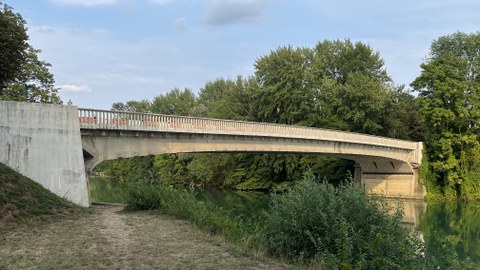
Pont de Luzancy
With darkness already setting in, we could see the landmark of France, the Eiffel Tower, from afar on our way to the City of a Thousand Lights. Probably the last challenge of the day was to find the car park in the centre of Paris. However, the car park was already closed when we arrived. After several phone calls in French, we were thankfully allowed to park our cars in the underground car park after all.
The next morning, we visited our partner university, the Université Gustave Eiffel. At the university, which opened in 2020, we were able to visit the test halls and exchange information about the respective research status, as well as establish new contacts between students and academic staff.
Another goal of the bridge-building excursion was to establish a partnership with the Université Gustave Eiffel. At the university, which opened in 2020, it was possible to visit the impressive experimental halls and exchange information about the respective research status, as well as to establish new contacts between students and academic staff. Prof. Jean Michel Torrenti gave us an overview of the exciting research topics. At the end of the first day in Paris, we spent the evening with baguettes and wine at the Seine with a view of the bridges of the Île de la Cité.
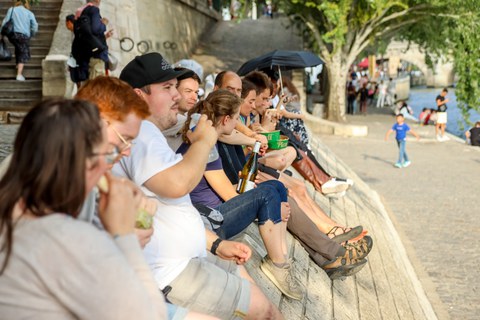
Dinner on the Seine in Paris
One finding of the fourth excursion day was that construction site safety is of great importance on many construction sites in France. The background was our visit to the construction site "Franchissement Urban Pleyel". This urban overpass with a length of 300 m in the north of Paris is to connect the Olympic sports facilities with the metro station. A particular challenge at this construction site was the insertion of the steel bridge during ongoing railway operations. During a subsequent walk along the Seine, the students gave short lectures on selected Seine bridges (Pont des Arts, Pont Neuf, Passerelle Simone-de-Beauvoir) as well as on the Eiffel Tower.
After two nights in the French capital, it was "Au revoir". The next destination was the Auvergne-Rhône-Alpes region south of Paris. On the way there, we passed the Pont Boutiron, also a bridge by Eugène Freyssinet, and the Viaduc de Fades, an old railway bridge.
The destination of the sixth day was one of the highlights of the excursion for many of us. After a visit to the Garabits Viaduct and a swim in the Truyére River under the Garabit Viaduct, the next item on our agenda was Viaduc de Millau. The bridge is the longest cable-stayed bridge in the world (2460 m) and also the highest bridge in Europe. In the nearby visitor centre we had the opportunity to follow the design and construction process. Completed in 2004, the bridge carries the four-lane A75 motorway at a height of 270 m over the valley of the River Tarn and has a maximum span of 342 m for the six inner spans. The Viaduc de Millau consists of eight spans supported by seven steel pylons by means of stay cables in the harrow system. The span of the two edge spans is 204 m each. The bridge's load-bearing system corresponds to that of a multi-cable bridge, whereby several cable-stayed bridge spans are coupled one behind the other. The design developed by Michel Virlogeux and other planners involved was awarded the "Outstanding Structure Award" by IABSE in 2006.
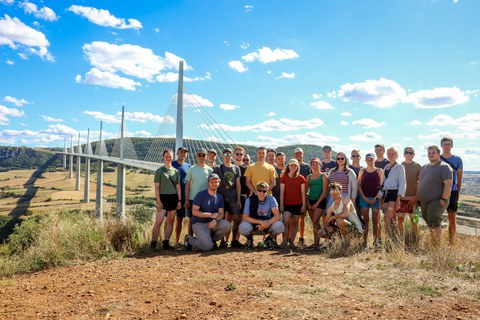
Excursion group in front of the Viaduc de Millau
On the seventh day, we continued to Montpellier on the Mediterranean Sea. While some of the group relaxed on the Mediterranean, others used the time for a short tour of the historic old town. Afterwards, the next stop was the Pont du Gard, an approximately 2000-year-old Roman aqueduct. Built around 50 AD, the three-level stone arch bridge formed part of the Roman aqueduct near Nimes. The bridge, which consists of 52 arches, is one of the best-preserved masterpieces of Roman architecture. The individual arches are between 3 and 6 m wide. The structure uses the real arch as the main supporting structure. This means that the resulting compressive forces can be ideally transferred to the support points.
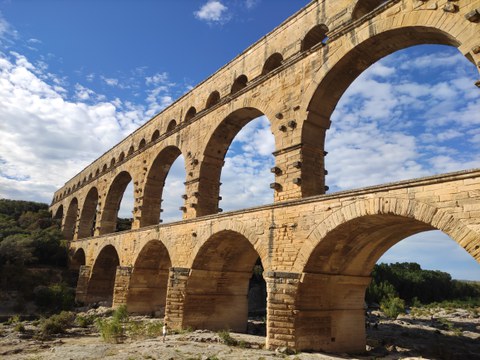
Pont du Gard
After a refreshing swim in the river Garonne below the Pont du Gard, we could start our journey to the last destination of the day, Avignon. We ended the day with a short city tour through the old town of Avignon and a visit to a restaurant.
After a night on the 'Île des Papes in Avignon, the first stop was "Pont Julien". This stone arch bridge was built as early as 3 BC and is still used as a cycle path today. The Pont Julien is considered one of the best preserved Roman bridges in all of France. We then visited the construction site of the world's largest nuclear fusion reactor, ITER. After an interesting guided tour, the day's destination was the campsite at Grand Lac de Laffrey. This mountain lake, located in the French Pre-Alps, with its spectacular landscape was another highlight of the excursion for many of us.
The ninth day began at 4 am with a hike to a nearby mountain for sunrise. Despite the early hour and fresh temperatures, 13 participants dared to get out of their warm sleeping bags. As a reward, we enjoyed a beautiful sunrise with baguette and espresso on the top of the mountain. After the warming sun appeared, we went back to the campsite, took down our tents and continued to the suspension bridge "Passerelle Himalayenne". Once there, the dynamic behaviour of lightweight wire rope suspension bridges could be studied experimentally: To the delight of the students, to the chagrin of the rest of the hikers and tourists. The next stops were at the Monteynard dam and the Cize-Bolozon viaduct.
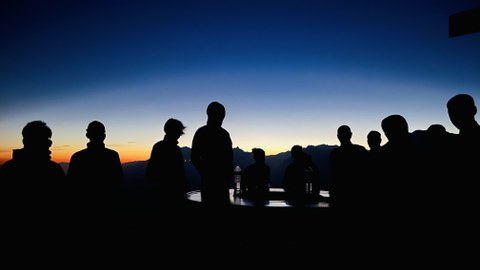
Sunrise in the French Alps
The penultimate day of the excursion took the group to Strasbourg in Alsace. In Strasbourg, besides the Port du Rhin, we visited several old arch bridges and the Passarelle de deux rives - the Rhine crossings between Germany and France. On our last evening together, we enjoyed Alsatian culture with tarte flambée and regional white wine.
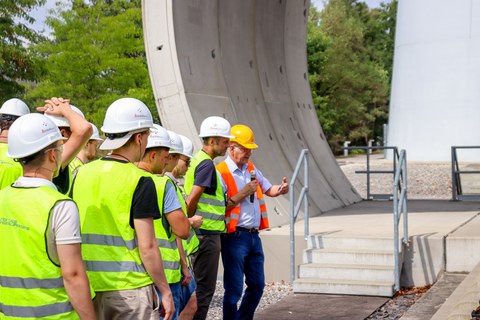
Guided tour of the Max Bögl precast concrete plant
On our last day, we had the opportunity to visit the Max Bögl precast plant in Sengenthal. The cleanliness and orderliness of the plant were striking, as were the very lean and optimally interlocking processes, e.g. for the production of tower segments for wind turbines. After a final stage, all excursion participants arrived healthy and happy in Dresden on the evening of the 11th day.
The bridge building excursion 2022 was a complete success for all participants. The group had already developed into a great unit before the excursion. Many new impressions were gained and we had the opportunity to deepen the theoretical contents of the lecture by means of real structures. At this point, we would like to thank all the supporters who made this trip possible and unforgettable for us. Thank you very much!
The participants of the excursion have compiled and published an elaborate and very readable travel report with many more photos. The digital version is available here as a PDF-Download. Many thanks to everyone involved for this great report!

